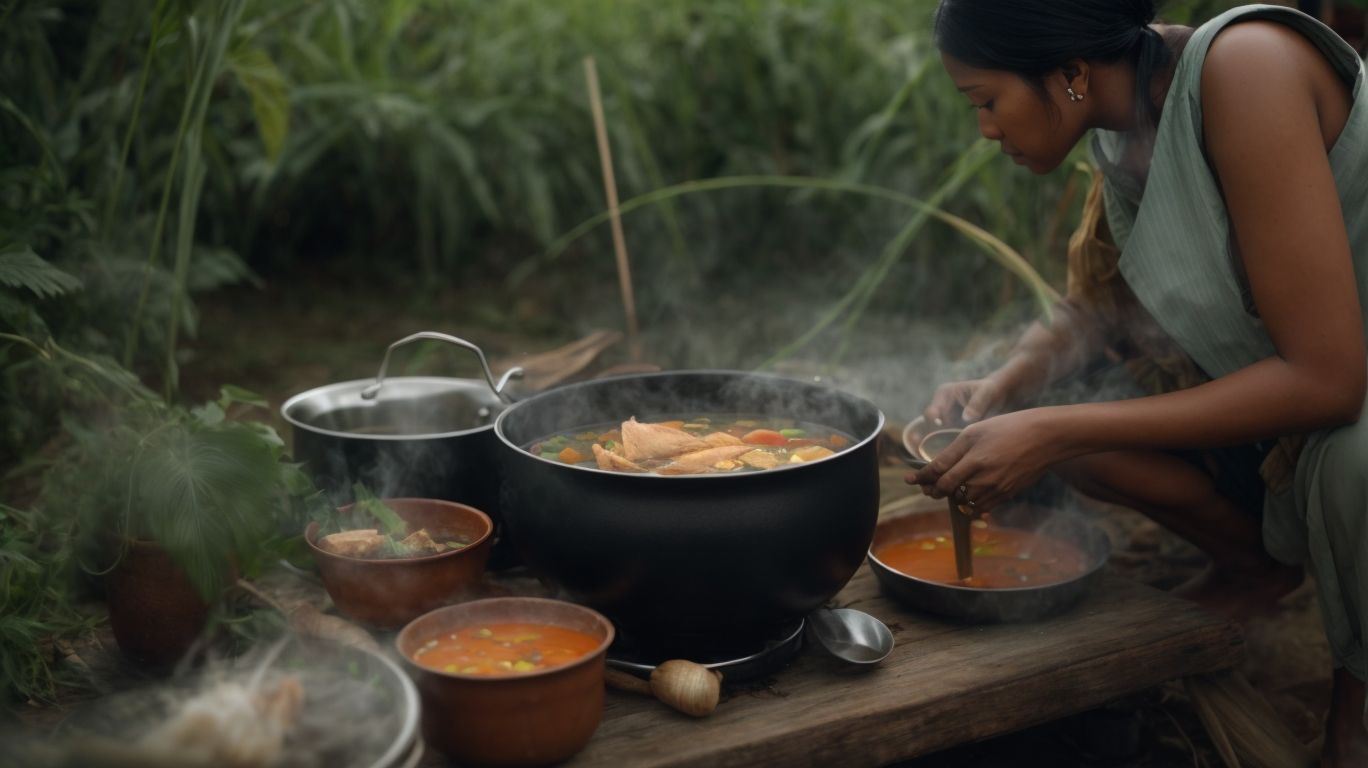How to Cook Nsala Soup With Catfish?
Looking to add some Nigerian flavors to your cooking repertoire?
Learn how to prepare Nsala Soup with catfish in this step-by-step guide.
We cover everything from preparing the ingredients to simmering and seasoning the soup.
Discover tips on choosing the best catfish, selecting seasonings, and adjusting the soup’s thickness.
Stay tuned for serving and pairing suggestions to enhance your Nsala Soup experience.
Key Takeaways:
What Is Nsala Soup?
Nsala Soup, also known as White Soup, is a traditional Nigerian delicacy that is popular among various tribes, characterized by its light color and rich flavor.
Nsala Soup originates from the southeastern part of Nigeria, particularly among the Igbo people, where it holds special cultural significance in celebrations and gatherings. The soup is traditionally made with either chicken or fish, pounded yam or fufu often served as accompaniments. The unique flavor of Nsala Soup comes from a blend of local spices and herbs, including utazi leaves and uziza seeds.
In different regions of Nigeria, variations of Nsala Soup can be found, each with its own twist on the traditional recipe. For example, in the western parts of the country, some versions incorporate ingredients like periwinkle or snails, adding a coastal influence to the dish.
What Are the Ingredients for Nsala Soup?
The ingredients for Nsala Soup typically include catfish, yam powder, utazi leaves, pepper, crayfish, and other aromatic spices that contribute to its unique taste profile.
The role of each ingredient in heightening the flavors of Nsala Soup is significant. Catfish, with its delicate flesh, provides a meaty and rich base to the soup. Utazi leaves add a slightly bitter yet refreshing taste, complementing the overall umami flavor. Pepper, offering a kick of heat, balances the dish’s savory notes. The inclusion of crayfish imparts a depth of seafood essence, enriching the broth.
While these ingredients are central, yam powder plays a crucial role in thickening the soup to a creamy consistency. In the absence of utazi leaves, spinach can be a suitable substitute, providing a different but equally enjoyable taste profile. Similarly, if catfish is not available, tilapia or red snapper can be used as alternatives without compromising the essence of the dish.
Step-by-Step Guide on How to Cook Nsala Soup with Catfish
Preparing Nsala Soup with catfish involves a series of steps that ensure the flavors are infused perfectly into the dish, resulting in a delightful culinary experience.
Step 1: Prepare the Catfish
The first step in making Nsala Soup is to prepare the catfish by cleaning, gutting, and cutting it into suitable pieces for cooking, ensuring freshness and quality in the final dish.
When cleaning the catfish, it is crucial to thoroughly rinse it under cold water to remove any impurities. Removing scales with a descaling tool or scraping them off with a knife helps enhance the texture of the fish.
De-gutting the catfish involves carefully removing the internal organs, paying attention to avoid puncturing the bile sac which can lead to bitterness in the dish. After cleaning, the catfish should be cut into chunks or fillets, depending on personal preference or recipe requirements. Proper handling of seafood is essential to maintain hygiene standards and prevent any contamination during the cooking process.
Step 2: Prepare the Other Ingredients
Gather and prepare the remaining ingredients for Nsala Soup, including yam powder, utazi leaves, crayfish, and spices, ensuring that each component is fresh and ready for use in the recipe.
In terms of the yam powder, it is crucial to select a high-quality variant to ensure the soup’s authentic texture. The yam powder thickens the soup and gives it a satisfying consistency that complements the other ingredients.
Utazi leaves are an essential element that brings a unique bitterness to the dish, balancing the flavors effectively. The crayfish, commonly used in Nigerian cuisine, adds a rich, savory depth to the soup. The blend of spices, including cloves, coriander, and ginger, enhances the overall aroma and taste, providing a harmonious blend of flavors.
Step 3: Blend the Ingredients
Blend the ingredients such as pepper, crayfish, and other spices to create a flavorful paste that will serve as the base for the Nsala Soup, ensuring a harmonious blend of aromas and tastes.
When combining these elements, it’s crucial to achieve the ideal balance of heat, earthiness, and umami flavors – a signature characteristic of this traditional Nigerian dish.
Crucially, consider the proportions carefully to maintain the right level of spiciness without overpowering the delicate flavors of the meat or fish that will be added later.
The consistency of the paste should be smooth and fine, ensuring a seamless incorporation into the broth during the cooking process.
Step 4: Cook the Catfish
Cook the prepared catfish in a flavorful broth until tender and infused with the aromatic flavors of the soup base, ensuring that the fish retains its natural taste and texture.
When cooking the catfish for Nsala Soup, it is important to allow ample time for the fish to absorb the rich flavors of the broth. The slow simmering process helps the fish soak up the essence of the ingredients, enhancing its overall taste profile. This technique is a hallmark of traditional Nigerian cooking, where patience and attention to detail yield a dish bursting with complex flavors.
Step 5: Add the Blended Ingredients
Add the blended spice paste to the cooked catfish, allowing the flavors to meld together harmoniously while simmering to create a rich and aromatic broth for the Nsala Soup.
Incorporating the blended spice paste into the tender catfish elevates the dish to new heights of flavor complexity. The paste, crafted typically with aromatic ingredients like negro pepper, uziza seeds, and crayfish, infuses the fish with a depth of taste unparalleled. By controlling the heat during the simmering process, the essence of the paste penetrates the fish slowly, ensuring every bite bursts with traditional Nigerian flair.
Step 6: Simmer and Season the Soup
Simmer the soup to allow the flavors to develop and intensify, adjusting the seasoning as needed to achieve the desired taste profile of the Nsala Soup, balancing the spices and aromatics.
Simmering is a crucial step in Nigerian cuisine, especially in the preparation of Nsala Soup. By gently cooking the ingredients over low heat, the flavors are given time to meld and deepen, creating a rich and savory base.
Seasoning plays a significant role in elevating the taste of this traditional dish. Nigerian culinary traditions emphasize the art of balancing flavors, and in Nsala Soup, the right blend of spices can transform a simple soup into a culinary masterpiece.
Tips for Making the Perfect Nsala Soup
Achieving the perfect Nsala Soup requires attention to detail, fresh ingredients, and the right balance of spices and seasonings to create a delightful culinary masterpiece.
How to Choose the Best Catfish for Nsala Soup?
Selecting the best catfish for Nsala Soup involves choosing fresh, firm fish with a mild flavor that complements the other ingredients in the dish, enhancing the overall taste experience.
When selecting catfish, look for fish that has clear eyes, shiny scales, and a clean, slightly sweet scent, indicating its freshness. The texture of the fish should be firm, not mushy, ensuring it holds up well during cooking. The flavor of the catfish should be subtle, allowing it to blend harmoniously with the spicy, aromatic components of the Nsala Soup. Ensuring these qualities in the catfish will elevate the flavors of the dish and result in a delightful culinary experience.
What Are the Best Seasonings for Nsala Soup?
The best seasonings for Nsala Soup include utazi leaves, crayfish, pepper, and traditional Nigerian spices that add depth, aroma, and flavor complexity to the dish.
Utazi leaves, known for their slightly bitter taste, provide a unique flavor profile to Nsala Soup, balancing the richness of the broth while imparting a refreshing note.
Crayfish, a staple in Nigerian cuisine, offers a delicious umami undertone and a hint of sweetness, enhancing the overall savory character of the soup.
Pepper, whether in the form of freshly ground black pepper or spicy scotch bonnet peppers, brings a gentle heat that elevates the dish without overwhelming the delicate flavors.
Traditional Nigerian spices, such as cloves, nutmeg, and alligator pepper, infuse the soup with warmth, complexity, and a touch of earthiness, creating a harmonious blend of flavors.
How to Adjust the Thickness of the Soup?
To adjust the thickness of Nsala Soup, consider adding more yam powder gradually or incorporating a roux mixture to achieve the desired consistency, ensuring a balanced and velvety texture.
Another effective method for thickening Nsala Soup is to simmer it uncovered for a longer period, allowing the liquid to reduce naturally and intensify the flavors in the process. This slow cooking technique not only enhances the thickness but also enriches the overall taste profile of the soup.
For those who prefer a smoother texture, blending a portion of the soup and then mixing it back in can create a creamier mouthfeel without compromising on the traditional chunky elements that make Nsala Soup distinctive.
Consider incorporating palm oil in moderation to not only contribute to the thickness but also infuse the soup with its signature earthy flavor, adding another layer of complexity to this beloved Nigerian dish.
Serving and Pairing Suggestions for Nsala Soup
When serving Nsala Soup, consider pairing it with traditional Nigerian sides such as pounded yam, fufu, or rice, and complementing it with refreshing drinks that enhance the overall dining experience.
What Are the Best Side Dishes for Nsala Soup?
Popular side dishes that pair well with Nsala Soup include pounded yam, eba, garri, or rice, offering a balanced meal that combines the rich flavors of the soup with complementary textures.
Adding to the array of accompaniments, plantains are another popular choice to serve alongside Nsala Soup, providing a delightful contrast between the savory broth and the sweetness of ripe plantains.
In Nigerian culture, side dishes play a significant role in balancing the overall flavors of a meal, with each component carefully selected to enhance the dining experience.
The gastronomic diversity of Nigerian cuisine allows for a harmonious blend of different textures, tastes, and aromas, ensuring that every bite is a sensorial delight.
What Drinks Go Well with Nsala Soup?
Complement the flavors of Nsala Soup with refreshing beverages like palm wine, zobo drink, or freshly squeezed fruit juices that offer a delightful contrast to the savory notes of the dish.
When enjoying Nsala Soup, the rich and slightly tangy taste of palm wine can enhance the overall dining experience, cutting through the richness of the soup with its unique flavor. Alternatively, the hibiscus-based zobo drink, known for its deep red color and refreshing tartness, serves as a vibrant palate cleanser between the hearty spoonfuls of the soup, balancing out the spice and heat.
For those seeking a non-alcoholic option, freshly squeezed fruit juices like pineapple, orange, or watermelon can elevate the flavors of the soup with their natural sweetness and acidity, providing a burst of freshness with every sip.
Frequently Asked Questions
How do I make Nsala Soup with Catfish?
To make Nsala Soup with Catfish, you will need the following ingredients: catfish, crayfish, utazi leaves, uziza leaves, stockfish, dry fish, fresh pepper, onion, salt, and seasoning cubes. Follow these easy steps to cook the soup:
- Step 1: Wash and clean the catfish and set aside.
- Step 2: Blend the crayfish, utazi and uziza leaves, and fresh pepper together.
- Step 3: In a pot, add the blended mixture, stockfish, dry fish, and onion.
- Step 4: Add water and let it cook for about 15 minutes.
- Step 5: Add the catfish and let it cook for an additional 10 minutes.
- Step 6: Season with salt and seasoning cubes to taste.
- Step 7: Serve with your preferred swallow or rice.
What is the best type of catfish to use for Nsala Soup?
The best type of catfish to use for Nsala Soup is the fresh, whole catfish. It is important to use fresh catfish as it adds a unique flavor to the soup. You can also use dried catfish, but fresh catfish is recommended for the best results.
Can I substitute the utazi and uziza leaves?
Yes, you can substitute the utazi and uziza leaves with bitter leaves. However, the taste and aroma of the soup will be slightly different. It is best to use the recommended leaves for the authentic taste of Nsala Soup.
How can I make the soup thicker?
If you prefer a thicker consistency for your Nsala Soup, you can add a thickening agent such as cocoyam paste or yam paste. Simply mash boiled cocoyam or yam and add it to the soup while cooking, stir and let it cook for an additional 5 minutes.
Can I freeze leftover Nsala Soup?
Yes, you can freeze leftover Nsala Soup for up to 2 months. Make sure to let the soup cool completely before transferring it to an airtight container and placing it in the freezer. When ready to eat, thaw the soup in the refrigerator and reheat on the stove.
What is the best way to reheat Nsala Soup?
The best way to reheat Nsala Soup is on the stove over medium heat. This will ensure that the soup is heated evenly and maintains its flavor and texture. You can also reheat it in the microwave, but make sure to stir occasionally to prevent any hot spots.






